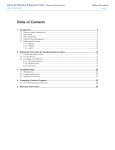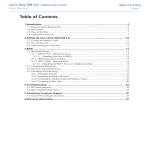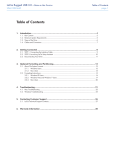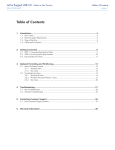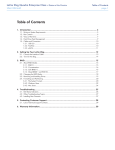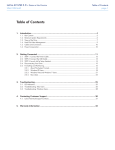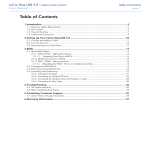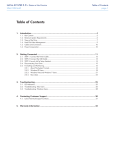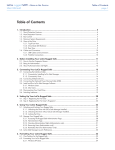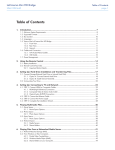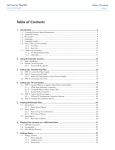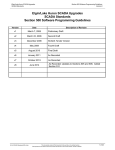Download LaCie 2TB 2big USB 3.0
Transcript
LaCie 2big USB 3.0 • DESIGN BY NEIL POULTON User Manual Table of Contents page 1 Table of Contents 1.Introduction............................................................................................................... 4 1.1.Minimum System Requirements...................................................................................................... 5 1.2.Box Content................................................................................................................................. 6 1.3.Views of the Drive......................................................................................................................... 7 1.4.Cables and Connectors................................................................................................................. 9 2.Setting Up Your LaCie 2big USB 3.0........................................................................ 10 2.1.Connect the Interface Cable........................................................................................................ 11 2.2.Turn the Drive On....................................................................................................................... 12 2.3.Disconnecting Your Hard Drive.................................................................................................... 13 3.RAID........................................................................................................................ 14 3.1.About RAID Modes...................................................................................................................... 14 3.1.1. RAID 0 (FAST - High performance)..................................................................................... 14 3.1.2. JBOD (Just a bunch of disks)............................................................................................. 15 3.1.3. RAID 1 (SAFE - Data protection)......................................................................................... 16 3.2.Changing the RAID Mode............................................................................................................ 17 3.3.Removing and Installing Drives..................................................................................................... 19 3.4.Formatting and Partitioning.......................................................................................................... 20 3.4.1. File System Formats.......................................................................................................... 20 3.4.2. Formatting for Window XP Users........................................................................................ 22 3.4.3. Formatting for Windows Vista and Windows 7 Users............................................................ 25 3.4.4. Formatting for Mac Users.................................................................................................. 29 4.Troubleshooting...................................................................................................... 31 4.1.LED Status Indicators................................................................................................................... 32 4.2.Basic Troubleshooting Topics....................................................................................................... 33 5.Contacting Customer Support.................................................................................. 34 5.1.LaCie Technical Support Contacts................................................................................................ 35 6.Warranty Information.............................................................................................. 36 LaCie 2big USB 3.0 • DESIGN BY NEIL POULTON User Manual Copyrights Copyright © 2010 LaCie. All rights reserved. No part of this publication may be reproduced, stored in a retrieval system, or transmitted in any form or by any means, electronic, mechanical, photocopying, recording or otherwise, without the prior written consent of LaCie. Trademarks Apple, Mac, and Macintosh are registered trademarks of Apple Inc. Microsoft, Windows 95, Windows 98, Windows Me, Windows NT, Windows 2000, Windows XP, Windows Vista, and Windows 7 are registered trademarks of Microsoft Corporation. Other trademarks mentioned in this manual are the property of their respective owners. Changes The material in this document is for information only and subject to change without notice. While reasonable efforts have been made in the preparation of this document to assure its accuracy, LaCie assumes no liability resulting from errors or omissions in this document, or from the use of the information contained herein. LaCie reserves the right to make changes or revisions in the product design or the product manual without reservation and without obligation to notify any person of such revisions and changes. Canada Compliance Statement This Class B digital apparatus meets all requirements of the Canadian Interference-Causing Equipment Regulations. Japan Compliance Statement This is a Class B product based on the standard of the Voluntary Control Council for Interference from Information Technology Equipment (VCCI). If this is used near a radio or television receiver in a domestic environment, it may cause radio interference. Install and use the equipment according to the instruction manual. 100716v1.1 Foreword page 2 FCC Statement LaCie 2big USB 3.0 Tested to comply with FCC standards for home or office use This device complies with Part 15 of the FCC Rules. Operation is subject to the following conditions: 1. The devices may not cause harmful interference 2. The devices must accept any interference received, including interference that may cause undesired operation. NOTE: This equipment has been tested and found to comply with the limits for a Class B digital device, pursuant to Part 15 of the FCC Rules. These limits are designed to provide reasonable protection against harmful interference in a residential installation. This equipment generates, uses and can radiate radio frequency energy and, if not installed and used in accordance with the instructions, may cause harmful interference to radio communications. However, there is no guarantee that interference will not occur in a particular installation. If this equipment does cause harmful interference to radio or television reception, which can be determined by turning the equipment off and on, the user is encouraged to try and correct the interference by one or more of the following measures: ✦✦ Reorient or relocate the receiving antenna. ✦✦ Increase the separation between the equipment and receiver. ✦✦ Connect the equipment into an outlet on a circuit different from that to which the receiver is connected. ✦✦ Consult the dealer or an experienced radio/TV technician for help. Manufacturer’s Declaration for CE Certification We, LaCie, solemnly declare that this product conforms to the following European standards: Class B EN60950, EN55022, EN55024, EN61000-3-2: 2000, EN61000-3-3: 2001 With reference to the following conditions: 73/23/EEC Low Voltage Directive; 89/336/EEC EMC Directive This symbol on the product or on its packaging indicates that this product must not be disposed of with your other household waste. Instead, it is your responsibility to dispose of your waste equipment by handing it over to a designed collection point for the recycling of waste electrical and electronic equipment. The separate collection and recycling of your waste equipment at the time of disposal will help to conserve natural resources and ensure that it is recycled in a manner that protects human health and the environment. For more information about where you can drop off your waste equipment for recycling, please contact your local city office, your household waste disposal service, or the shop where you purchased the product. CAUTION: Modifications not authorized by the manufacturer may void the user’s authority to operate this device. CAUTION: A shielded-type power cord is required in order to meet FCC emission limits and also to prevent interference to the nearby radio and television reception. It is essential that only the supplied power cord be used. LaCie 2big USB 3.0 • DESIGN BY NEIL POULTON User Manual Health and Safety Precautions ✦✦ Only qualified persons are authorized to carry out maintenance on this device. ✦✦ Read this User Manual carefully and follow the correct procedure when setting up the device. ✦✦ Do not open a disk drive or attempt to disassemble or modify it. Never insert any metallic object into the drive to avoid any risk of electrical shock, fire, short-circuiting or dangerous emissions. The disk drives shipped with your LaCie 2big USB 3.0 contain no user-serviceable parts. If it appears to be malfunctioning, have it inspected by a qualified LaCie Technical Support representative. ✦✦ Never expose your device to rain, or use it near water, or in damp or wet conditions. Never place objects containing liquids on the LaCie 2big USB 3.0, as they may spill into its openings. Doing so increases the risk of electrical shock, short-circuiting, fire or personal injury. ✦✦ Make sure that the computer and LaCie 2big USB 3.0 are electrically grounded. If the devices are not grounded, there is an increased risk of electrical shock. General Use Precautions ✦✦ Power requirements 100-240 V~, 1.44 A, 50-60 Hz, (supply voltage fluctuations not exceeding ± 10% of the nominal and transient overvoltages according to over-voltage category II). ✦✦ Do not expose the LaCie 2big USB 3.0 to temperatures outside the range of 5° C to 35° C (41° F to 95° F); or to operational humidity beyond 5-80%, non-condensing, or non-operating humidity beyond 10-90%, non-condensing. Doing so may damage the LaCie 2big USB 3.0 or disfigure its casing. Avoid placing your LaCie 2big USB 3.0 near a source of heat or exposing it to sunlight (even through a window). Inversely, placing your LaCie 2big USB 3.0 in an environment that is too cold may damage the unit. ✦✦ Rated cooling for altitudes up to 2000 meters. ✦✦ Always unplug the LaCie 2big USB 3.0 from the electrical outlet if there is a risk of lightning or if it will be unused for an extended period of time. Otherwise, there is an increased risk of electrical shock, short-circuiting or fire. ✦✦ Use only the power supply shipped with the device. ✦✦ Do not use the LaCie 2big USB 3.0 near other electrical appliances such as televisions, radios or speakers. Doing so may cause interference which will adversely affect the operation of the other products. ✦✦ Do not place the LaCie 2big USB 3.0 near sources of magnetic interference, such as computer displays, televisions or speakers. ✦✦ Magnetic interference can affect the operation and stability of your LaCie 2big USB 3.0. ✦✦ Never use excessive force on your LaCie 2big USB 3.0. If you detect a problem, consult the Troubleshooting section in this manual. ✦✦ Protect your LaCie 2big USB 3.0 from excessive exposure to dust during use or storage. Dust can build up inside the device, increasing the risk of damage or malfunction. ✦✦ Never use benzene, paint thinners, detergent or other chemical products to clean the outside of the LaCie 2big USB 3.0. Such products will disfigure and discolor the casing. Instead, use a soft, dry cloth to wipe the device. ✦✦ Please replace defective hard drives only with a new drive provided by LaCie. For drive removal process, see section 3.3. Removing and In- Foreword page 3 stalling Drives. IMPORTANT INFO: Any loss, corruption or destruction of data while using a LaCie drive or drive system is the sole responsibility of the user, and under no circumstances will LaCie be held liable for the recovery or restoration of this data. To help prevent the loss of your data, LaCie highly recommends that you keep TWO copies of your data; one copy on your external hard disk, for instance, and a second copy either on your internal hard disk, another external hard disk or some other form of removable storage media. If you would like more information on backup, please refer to our web site. IMPORTANT INFO: 1TB (Terabyte) = 1,000GB. 1GB = 1000MB. 1MB = 1,000,000 Bytes. Total accessible capacity varies depending upon operating environment (typically up to 10% less per TB). Capacity and cache memory vary depending upon RAID mode. LaCie 2big USB 3.0 • DESIGN BY NEIL POULTON User Manual Introduction page 4 1.Introduction Congratulations on the purchase of your new LaCie 2big USB 3.0. The 2big USB 3.0 is the ultimate approach to a flexible RAID (Redundant Array of Independent/Inexpensive Disks) solution, with its ability to manage various RAID levels for a wide range of applications. Since needs differ among all users, the LaCie 2big USB 3.0 allows you to choose between faster transfer rates or file mirroring with a simple flip of a switch. For high-speed demanding programs, such as video editing or graphics, you may choose RAID 0 (FAST). If data backup is important, RAID 1(SAFE) will keep a copy of each file on the 2big’s two disks. Providing greater integrity and availability than standard hard disk storage, RAID technology is one of the best means to protect your data. With the USB 3.0 interface, you will experience enhanced transfer rates to compliment whatever RAID level you choose. Quick Links Click a topic: ✦✦ Connect the Interface Cable ✦✦ Turn the Drive On ✦✦ Changing the RAID Mode Features ✦✦ SuperSpeed USB 3.0, up to 5 Gb/s ✦✦ Backward compatible to Hi-Speed USB 2.0, up to 480 Mb/s ✦✦ Three RAID modes: RAID 0, RAID 1, JBOD ✦✦ Two removable SATA drives with locks ✦✦ Plug & play ✦✦ Optimized Power Management LaCie 2big USB 3.0 • DESIGN BY NEIL POULTON User Manual 1.1. Minimum System Requirements Operating System Interface Port Disk Space The latest versions USB 3.0** or USB Minimum of of Microsoft Win- 2.0 600MB recomdows XP*, Windows mended Vista, or Windows 7 The latest versions USB 3.0** or USB Minimum of of Mac OS 10.5.x, 2.0 600MB recomor 10.6.x mended *Windows XP will not recognize logical volumes greater than 2TB. For details, see section 3.4.1. File System Formats. **To take advantage of SuperSpeed USB 3.0 transfer rates, the LaCie 2big USB 3.0 must be connected to a USB 3.0 port. If your computer does not have a USB 3.0 port, you may add a USB 3.0 PCI-Express card (desktop computer) or a USB 3.0 ExpressCard 34 (portable). LaCie offers a wide selection of peripherals, including expansion cards. Visit the LaCie web site at www.lacie.com/accessories. TECHNICAL NOTE: The USB 3.0 interface may require additional drivers to operate on your computer. Please confirm that your operating system supports USB 3.0 and, if necessary, download the necessary drivers. TECHNICAL NOTE: The LaCie 2big USB 3.0 is compatible with USB 3.0 and USB 2.0 interfaces. When attaching the 2big USB 3.0 to a USB 2.0 port, transfer rates are limited to USB 2.0 speeds (up to 480 Mb/s). Introduction page 5 LaCie 2big USB 3.0 • DESIGN BY NEIL POULTON User Manual Introduction page 6 1.2. Box Content Your LaCie 2big USB 3.0 package contains the system tower and an accessories box containing the items listed below. 1 1. LaCie 2big USB 3.0 2. SuperSpeed USB 3.0 cable (compatible with USB 2.0) 3. Power supply kit 4. LaCie Utilities CD-ROM 5. Quick Install Guide 2 6. 2-in-1 RAID modification and drive removal tool 3 IMPORTANT INFO: Please save your packaging. In the event that the drive should need to be repaired or serviced, it must be returned in its original packaging. 4 5 2big USB 3.0 SuperSpeed USB 3.0 | Hi-Speed USB 2.0 Design by Neil Poulton Quick Install Guide 6 LaCie 2big USB 3.0 • DESIGN BY NEIL POULTON User Manual Introduction page 7 1.3. Views of the Drive Front View The blue LED (A) on the front of the LaCie 2big USB 3.0 serves as a status indicator for the RAID, and an on/off button (see Auto Power and Manual Shut Off for more information on the auto power function). A See troubleshooting section 4.1. LED Status Indicators for more information. Fig. 01 LaCie 2big USB 3.0 • DESIGN BY NEIL POULTON User Manual Introduction page 8 Rear View 1. Drive status LED 2. Drive tray handle 3. Drive lock DESIGNED BY NEIL POULTON 4. USB 3.0 port 5. Power input connection 6. RAID confirmation button Fast 1 JBOD Safe 7. RAID selection switch 7 CAUTION: To avoid overheating, the LaCie 2big USB 3.0 should be installed in a well-ventilated area and in such a way as to maintain sufficient airflow across the controller chips. Please use the included stand and rubber feet which elevate the 2Big and allow for better heat dissipation. 6 Confirm Environmental Requirements: Temperature: 0 – 35° C (32 – 95° F) Operation Humidity: 20 – 80%, non-condensing Storage Humidity: 10 – 90%, non-condensing 2 4 USB 3.0 3 5 Fig. 02 LaCie 2big USB 3.0 • DESIGN BY NEIL POULTON User Manual Introduction page 9 1.4. Cables and Connectors USB USB is a serial input/output technology for connecting peripheral devices to a computer or to other peripherals, such as USB hubs. Hi-Speed USB 2.0 is a common interface that supports high speed devices such as hard drives, CD/DVD drives, and digital cameras. SuperSpeed USB 3.0 offers transfer rates up to ten times faster than its predecessor. Included USB 3.0 Cable Hi-Speed USB 3.0 Benefits ✦✦ Backwards compatibility: Super-Speed USB 3.0 works with Hi-Speed USB 2.0 specifications. The transfer rates do not exceed USB 2.0 speeds. ✦✦ Hot-pluggable: no need to shut down or restart your computer when adding or removing devices. Your LaCie drive is shipped with a SuperSpeed USB 3.0 cable, to ensure maximum data transfer performance when connected to a SuperSpeed USB 3.0 port (up to 5 Gb/s). The cable is also backward compatible to accommodate Hi-Speed USB 2.0 ports (up to 480 Mb/s). Fig. 03 - USB 3.0 Cable TECHNICAL NOTE: The USB 3.0 interface may require additional drivers to operate on your computer. Please confirm that your operating system supports USB 3.0 and, if necessary, download the necessary drivers. TECHNICAL NOTE: The LaCie 2big USB 3.0 is compatible with USB 3.0 and USB 2.0 interfaces. When attaching the 2big USB 3.0 to a USB 2.0 port, transfer rates are limited to USB 2.0 speeds (up to 480 Mb/s). LaCie 2big USB 3.0 • DESIGN BY NEIL POULTON User Manual 2.Setting Up Your LaCie 2big USB 3.0 This section covers the installation and configuration of the LaCie 2big USB 3.0. Follow the steps below to power on and configure your 2big USB 3.0: Step 1: 2.1. Connect the Interface Cable Step 2: 2.2. Turn the Drive On Step 3: 3.4. Formatting and Partitioning – Format the drives to suit your storage needs. For more information about file system formats, see section 3.4.1. File System Formats. Setup page 10 LaCie 2big USB 3.0 • DESIGN BY NEIL POULTON User Manual Setup page 11 2.1. Connect the Interface Cable 1. Plug one end of the interface cable into the corresponding port (USB 3.0 or USB 2.0) on your host computer. 2. Connect the other end of the cable to the matching port on the 2big USB 3.0. DESIGNED BY NEIL POULTON USB 3.0 Fast JBOD Safe USB 3.0 Confirm Fig. 04 LaCie 2big USB 3.0 • DESIGN BY NEIL POULTON User Manual Setup page 12 2.2. Turn the Drive On The power supply kit is composed of two cables: one cable (A) connects to the LaCie drive; and the other cable (B) connects to a power outlet, such as a wall outlet or a surge protector. DESIGNED BY NEIL POULTON 1. Connect Cable A to the 2big USB 3.0. 2. Connect Cable B to the power supply brick (C). Fast JBOD Safe 3. Connect Cable B to a surge protector or wall outlet. 4. The 2big USB 3.0 is in auto mode by default. It will boot when plugged into a USB 3.0 or USB 2.0 slot on a computer that is powered on. Without a computer, push the LED button on the front to power on the 2big USB 3.0. B USB 3.0 Confirm The 2big USB 3.0 may take a few seconds to boot up. NOTE: Depending on your country, power outlet connections may be different from the illustration. C Auto Power and Manual Shut Off A The 2big USB 3.0 will shut off when: ✦✦ it is disconnected from the computer after unmounting the drives (2.3. Disconnecting Your Hard Drive) Fig. 05 ✦✦ shutting down the computer while the drives are connected and mounted on the desktop ✦✦ performing a long push on the front LED button while the drives are powered on. The 2big USB 3.0 will take more than a few seconds to switch off when using a long push as it finishes writing the last action. Your LaCie 2big USB 3.0 also conserves energy by powering off the LEDs and entering Eco mode automatically if the drives have not been used for 30 minutes. The partition(s) will remain on the desktop (Mac) or in My Computer (Windows) while the drives stay in Eco mode until the 2big USB 3.0 is accessed. CAUTION: Only use the AC adapter supplied with your specific LaCie device. Do not use a power supply from another LaCie device or another manufacturer. Using any other power cable or power supply may cause damage to the device and void your warranty. Always remove the AC adapter before transporting your LaCie drive. Failure to remove the adapter may result in damage to your drive and will void your warranty. TECHNICAL NOTE: You may use your LaCie drive when in a foreign country thanks to its 100-240 Volt power supply. To be able to use this feature, you may need to purchase an appropriate adapter or cord. LaCie accepts no responsibility for any damage to the drive resulting from the use of an inappropriate adapter. Using an adapter other than one authorized by LaCie will void your warranty. LaCie 2big USB 3.0 • DESIGN BY NEIL POULTON User Manual Setup page 13 2.3. Disconnecting Your Hard Drive USB devices feature “plug & play” connectivity, which means that a drive can be connected and disconnected while the computer is running. To prevent failures, it is important to follow the steps below before disconnecting your hard drive. Windows XP Users From the System Tray located in the lower right-hand side of your screen, click on the Eject icon (a small green arrow over a hardware image) (Fig. 06 – Windows XP Users). Fig. 06 – Windows XP Users A message will appear, detailing the devices that the Eject icon controls, i.e. “Safely remove…” Select the disk you wish to unmount. You will then be given the following message: “‘The USB Mass Storage Device’ device can now be safely removed from the system”. It is now safe to disconnect the device. Fig. 07 – Windows Vista/Windows 7 Users Windows Vista/Windows 7 Users From the System Tray located in the lower right-hand side of your screen, click on the plug icon (note the white check mark inside a green circle). Fig. 07 – Windows Vista/Windows 7 UsersA message will appear, detailing the devices that may be safely unmounted. Fig. 08 – Windows Vista/Windows 7 Users Fig. 08 – Windows Vista/Windows 7 Users Select Eject for the device you wish to unmount. A message will appear notifying you that it is safe to remove the device. Mac Users Drag the hard drive icon to the trash (Fig. 09 – Mac Users). The drive can now be disconnected. Fig. 09 – Mac Users IMPORTANT INFO: For maximum energy efficiency, the 2big USB 3.0 will automatically shut down when it is unplugged from the computer. LaCie 2big USB 3.0 • DESIGN BY NEIL POULTON User Manual RAID page 14 3.RAID 3.1. About RAID Modes This section will help you decide which RAID mode is right for your application. RAID Mode Capacity RAID 0 (FAST) 100% JBOD 100% RAID 1 (SAFE) 50% Protection Speed 3.1.1. RAID 0 (FAST - High performance) The 2big USB 3.0 is pre-configured in RAID 0, the faster level of RAID. Requiring at least two drives, RAID 0 stripes data onto each disk. The available capacities of each disk are added together so that one logical volume mounts on the computer. In the event that one disk in the array fails, all the files become inaccessible because parts of each string of data have been written to all the disks. See Fig. 10. Applications RAID 0 is ideal for users who need maximum speed and capacity. Video editors working with very large files may use RAID 0 when editing multiple streams of video for optimal playback performance. While a RAID 0 array is suited for actively working with files, users interested in a higher level of security should consider RAID 1. Fig. 10 A1 A2 B1 B2 C1 D1 C2 D2 Disk 1 Disk 2 LaCie 2big USB 3.0 • DESIGN BY NEIL POULTON User Manual RAID page 15 3.1.2. JBOD (Just a bunch of disks) When the 2big USB 3.0 is set to JBOD, each drive is considered a separate device, similar to individual hard disk drives. Each disk will mount on your computer as separate hard drives, divided into the partitions created by your operating system’s disk management utility. One great advantage of JBOD is the use of the full capacity of both drives. Also, in the event of a single drive failure, files stored on the healthy drive are not lost. However, this configuration offers none of the benefits of RAID 0 (speed) or RAID 1 (complete data protection). JBOD Applications JBOD can be used with any application. In the event of a single drive failure, files on the healthy drive will not be lost. However, choosing to forgo RAID 0 and RAID 1 does have its drawbacks since superior performance or total data security will not be available. A E I B F J C D G H K L Disk 1 Fig. 11 Disk 2 LaCie 2big USB 3.0 • DESIGN BY NEIL POULTON User Manual RAID page 16 3.1.3. RAID 1 (SAFE - Data protection) In RAID 1, the two physical disks are mirrored together so that one single logical volume mounts on the desktop. Please note that the combined storage will not exceed the available capacity of the lowest-capacity single disk. All data is saved simultaneously on each disk (Fig. 12). If one physical disk fails, the data is available immediately on the second disk. No data is lost if one disk fails. Applications ✦✦ Maximum data safety ✦✦ RAID 1 reduces the total available capacity by 50% because two copies of the data are saved. A1 A1 B1 B1 C1 D1 E1 C1 D1 E1 Disk 1 Disk 2 Fig. 12 CAUTION: Your LaCie 2big USB 3.0 comes preconfigured in RAID 0, which provides faster transfer rates and allows access to the whole storage capacity. Unlike RAID 1, it does not provide any security. If a drive fails, all data will be lost. If you are concerned about data security, LaCie highly recommends changing your 2big USB 3.0 to RAID 1. See section 3.1. About RAID Modes, for more information. LaCie 2big USB 3.0 • DESIGN BY NEIL POULTON User Manual RAID page 17 3.2. Changing the RAID Mode See section 3. RAID to become familiar with the levels of RAID available to the 2big USB 3.0 before following the steps below. IMPORTANT INFO: Changing the level of RAID will require that you format the LaCie 2big USB 3.0. Please back up any data stored on the LaCie 2big USB 3.0 before following the steps below. DESIGNED BY NEIL POULTON Tool RAID Selection Switch CAUTION: Your LaCie 2big USB 3.0 comes preconfigured in RAID 0, which provides faster transfer rates and allows access to the whole storage capacity. Unlike RAID 1, it does not provide any security. If a drive fails, all data will be lost. If you are concerned about data security, LaCie highly recommends changing your 2big USB 3.0 to RAID 1. See section 3.1. About RAID Modes, for more information. Fast RAID Confirmation Button USB 3.0 ✦✦ Left = RAID 0 (FAST) ✦✦ Center = JBOD ✦✦ Right = RAID 1 (SAFE) T he RAID confirmation button is below the RAID selection switch; a small circular slot with a button inside (Fig. 13). The 2big USB 3.0 must be turned on to change the level of RAID. Attach the power cable if it is disconnected. Switch on the 2big USB 3.0 by pressing the front LED button. The front LED will blink as the RAID boots. It will become solid blue when ready. 1. Unmount the 2big USB 3.0 volumes from your computer (2.3. Disconnecting Your Hard Drive) and disconnect the interface cable. 2. To modify the level of RAID, use the 2-in-1 tool to slide the switch to the desired position (Fig. 13). 3. Validate the new level by pushing the RAID confirmation button with the 2-in-1 tool (Fig. 13). The 2big USB 3.0 will turn off to signal the RAID change confirmation. 4. Reattach the USB 3.0 cable to your computer. The 2big USB 3.0 will start automatically if the computer is on. The new RAID level has been successfully configured. 5. Format the disks. See section 3.4. Formatting and Partitioning. continued on the next page>> Safe Confirm Note the rectangular slot located between the two drive trays on the back of the 2big USB 3.0 (Fig. 13). This is the RAID selection switch. There is a switch inside the slot used for selecting the level of RAID: To change the RAID mode: JBOD Fig. 13 LaCie 2big USB 3.0 • DESIGN BY NEIL POULTON User Manual IMPORTANT INFO: You must partition the disk drives after changing the RAID mode. See section 3.4. Formatting and Partitioning. CAUTION: Disk drives must be inserted correctly in the 2big USB 3.0 before changing the RAID level. TECHNICAL NOTE: The drive status LEDs on the rear of the 2big USB 3.0 will blink with disk activity. See 4.1. LED Status Indicators for more information on LED behavior. RAID page 18 LaCie 2big USB 3.0 • DESIGN BY NEIL POULTON User Manual Installing Drives page 19 3.3. Removing and Installing Drives In the event that an individual hard disk fails in the LaCie 2big USB 3.0, please contact your LaCie reseller or LaCie Customer Support. Please replace a defective hard drive only with a new drive provided by LaCie. For drive removal and replacement process, please follow the steps below. CAUTION: After continuous use of the LaCie 2big USB 3.0, drives may be hot. Use caution when removing. IMPORTANT NOTE: A replacement drive must have the same or greater capacity than the drive it is replacing. To Remove a Drive: ✦✦ RAID 0 or JBOD: Turn off the 2big USB 3.0 and unplug it. ✦✦ RAID 1: The 2big USB 3.0 may stay on while removing the disk. 1. The drive tray may be locked. To unlock it, insert the round end of the provided 2-in-1 tool into the slot on the drive lock and turn the lock until the slot is vertical (Fig. 14). 2. Draw out the drive tray by inserting your finger into the space behind the drive tray handle and pulling to disengage the drive (Fig. 15). 3. Grasp the drive tray handle and carefully extract the drive (Fig. 15). ✦✦ RAID 0: Turn the 2big USB 3.0 on. To use the remaining drive, you must format it (See 3.4. Formatting and Partitioning). ✦✦ RAID 1 or JBOD: If it is off, turn the 2big USB 3.0 on to use the remaining drive. Please note that RAID 1 requires a second disk to mirror data. Fig. 14 IMPORTANT NOTE: LaCie highly recommends replacing the disk that has been removed. continued on the next page>> Fig. 15 LaCie 2big USB 3.0 • DESIGN BY NEIL POULTON User Manual To Install a Drive: 1. If the 2big USB 3.0 is configured in RAID 0, turn the device off and unplug it. If the 2big USB 3.0 is configured in RAID 1, you can leave it turned on and continue to step 2. 2. Carefully insert the drive tray into an empty drive bay. When the drive tray is almost flush, you will feel a bit of resistance. Press the drive tray handle firmly until the drive snaps into place and it is in line with the back pane of the 2big USB 3.0. 3. Use the 2-in-1 tool to lock the drive lock. Turn the lock until the grooves are vertically oriented. The drives are locked when both locks are vertical. TECHNICAL NOTE: Data is still accessible during a RAID 1 rebuild. The 2big USB 3.0 can be disconnected from the workstation during the rebuild; only the power must be connected.Important Info: Drive warranty will be void if you replace the defective drive with a drive not provided by LaCie. Drives purchased from LaCie are shipped pre-installed in drive trays with handles. IMPORTANT INFO: In order for rebuilding to occur in RAID 1 mode, the product must be turned on while a replacement disk is installed. IMPORTANT INFO: Rebuilding a RAID 1 array can take several hours. For example, rebuilding a 1TB RAID 1 array can take more than three hours. LaCie does not recommend removing any drives during a rebuild. Installing Drives page 20 LaCie 2big USB 3.0 • DESIGN BY NEIL POULTON User Manual Formatting page 21 3.4. Formatting and Partitioning The 2big USB 3.0 comes pre-formatted in NTFS, optimized for Windows XP, Windows Vista, and Windows 7. Please read the following information on file system formats for Windows and Mac operating systems to determine if you need to reformat the 2big USB 3.0. See sections 3.4.2. Formatting for Window XP Users, 3.4.3. Formatting for Windows Vista and Windows 7 Users, and 3.4.4. Formatting for Mac Users for formatting instructions. 3.4.1. File System Formats Windows Users The LaCie 2big USB 3.0 comes preformatted in NTFS for optimum performance with Windows XP, Windows Vista, and Windows 7. TECHNICAL NOTE: Windows XP 32-bit does not support volumes greater than 2TB. Windows XP x64, Windows Vista, and Windows 7 allow for partitions greater than 2TB but the disk must be converted to the GPT file system. This process is outlined in 3.4.3. Formatting for Windows Vista and Windows 7 Users. FAT 32 FAT is an acronym for File Allocation Table, which dates back to the beginnings of DOS programming. Originally, FAT was only 16 bits, but after the second release of Windows 95 it was upgraded to 32 bits, hence the name FAT 32. In theory, FAT 32 volume sizes can range from less than 1MB all the way to 2TB. It is the native file system of Windows 98 and Windows Me, and is supported by Windows XP, Windows Vista, and Windows 7. When FAT 32 is used with Windows XP, Windows Vista, and Windows 7, volume size is limited to 32GB (by the Windows partition utility Disk Management), and the individual file size is limited to 4GB. NTFS This acronym stands for New Technology File System, and it is the native file system for Windows NT, Windows 2000, Windows XP, Windows Vista, and Windows 7. NTFS offers several features that are not available with FAT 32, such as file compression, encryption, permissions, auditing, and enhanced RAID capabilities. The minimum supported volume size for NTFS is 10MB, with a maximum of 2TB when initialized in MBR format or without a limit when initialized in GPT format. continued on the next page>> File System Formats There are two primary file system formats compatible with the Windows operating systems – NTFS and FAT32 (MSDOS). Use the information below to determine which format is best for you. Use NTFS if… ...you will be using the drive only with Windows XP, Windows Vista, and/or Windows 7 (performance will generally be greater when compared to FAT 32). This file system is compatible in read only mode with Mac OS X 10.3 and higher. See technical note at left for information on the 2TB volume size limitation. Use FAT 32 (MS-DOS) if… ...you will be using your drive with both Windows and Mac OS X 10.3. Maximum single file size is 4GB. LaCie 2big USB 3.0 • DESIGN BY NEIL POULTON User Manual Mac OS X Users: The LaCie 2big USB 3.0 comes preformatted in NTFS, a file system native to Windows. While Mac OS X can read NTFS, writing data is not supported. You may customize the drive by reformatting and/or partitioning the 2big USB 3.0 for optimal performance in Mac OS environments. Formatting page 22 File System Formats There are two file system formats recommended by LaCie when using the 2big USB 3.0 with the Mac OS – Extended (HFS+) and FAT32 (MS-DOS). Use the information below to determine which format is best for you. Mac OS Extended (HFS+) Mac OS Extended refers to the file system used by Mac OS X. HFS+ uses hard disk space more efficiently and is not limited by block size. Use Extended (HFS+) if… ...you will be using the drive only within a Mac OS X environment. This file system is not compatible with Windows. MS-DOS File System (FAT 32) This is the Microsoft file system, more typically known as FAT 32. Use this file system if you are going to move your LaCie hard disk drive between Mac and Windows operating systems. Use FAT 32 (MS-DOS) if… ...you will be using your drive with both Windows and Mac. Maximum single file size is 4GB. LaCie 2big USB 3.0 • DESIGN BY NEIL POULTON User Manual Formatting page 23 3.4.2. Formatting for Window XP Users The steps listed below will help you format and partition your disk drive using Windows XP. Please see 3.4.3. Formatting for Windows Vista and Windows 7 Users or 3.4.4. Formatting for Mac Users for instructions on formatting using alternative operating systems. For more information on the optimal file format, go to 3.4.1. File System Formats. CAUTION: Following these steps will erase everything from the 2big USB 3.0. Please back up all data that you want to preserve before performing these steps. IMPORTANT NOTE: Windows XP 32-bit does not recognize volumes greater than 2TB. Windows XP x64, Windows Vista (32and 64-bit versions), and Windows 7 (32- and 64-bit versions) recognize volumes greater than 2TB but the disks must be converted to the GPT file system. Fig. 16 1. Connect the drive to the power source and to the computer via the interface port. 2. Right-click My Computer and select Manage. 3. From the “Computer Management” window, select Disk Management (located below the Storage group). 4. If the “Initialize and Convert Disk Wizard” window appears, click Cancel. 5. Windows will list the hard disks that are installed on the system (Fig. 16). If there is a red circle with a white line, you must initialize the disk. Right-click the icon to select Initialize. Fig. 17 6. In the rectangular box to the right that says “Unallocated” or lists partitions from a previous format, right-click and select New Partition… 7. On the first page of the “New Partition Wizard” (Fig. 17). Click Next. 8. Select the Primary or Extended option (Fig. 18). Click Next. continued on the next page>> Fig. 18 LaCie 2big USB 3.0 • DESIGN BY NEIL POULTON User Manual Formatting page 24 9. Specify the partition size. Please note that FAT32 partitions must be 32GB (32000MB) or smaller. By default, the partition occupies the entire volume (Fig. 19) but you may change the size based upon the working environment. Click Next. 10. Assign a drive letter or mount path (Fig. 20). Click Next. 11. Select the file format for the disk (FAT32 will only appear as an option if the partion is 32GB or less - see 3.4.1. File System Formats). Once FAT32 or NTFS has been selected (Fig. 21), you have the option to Perform a quick format, which allows for a much faster format. While Disk Management does not check the drive for errors as extensively with a quick format, the option does save a significant amount of time. Click Next. Fig. 19 continued on the next page>> Fig. 20 Fig. 21 LaCie 2big USB 3.0 • DESIGN BY NEIL POULTON User Manual Formatting page 25 12. A window appears listing your choices. If all seems well, click Finish to begin the format process (Fig. 22). To make a change, select Back. 13. Your drive’s partition(s) should have a “Healthy” status in the list of drives in Disk Management (Fig. 23). You will also see the drive’s partition(s) in My Computer. The drive is ready for use. IMPORTANT INFO: Please refer to section 3.4.1. File System Formats, for a more detailed comparison of the various file system formats. Fig. 22 Fig. 23 LaCie 2big USB 3.0 • DESIGN BY NEIL POULTON User Manual Formatting page 26 3.4.3. Formatting for Windows Vista and Windows 7 Users Master Boot Record or GUID Partition Table? Master Boot Record (MBR) partitioning has been the hard drive standard for many years. It supports a maximum of four primary partitions with a size limit of 2TB per partition. Due to partition limitations in the face of ever-expanding hard disk drive sizes, Global Unique Identifier Partition Tables (GPT) has been established to allow for more partitions with greater capacities. Further, GPT has many additional advantages that may offer enhancements in performance. Fig. 24 However, GPT is not compatible with Windows XP 32-bit. While Windows XP 64-bit supports GPT, it is best to use MBR if you intend to share your LaCie device with computers running Windows XP 32-bit. Switching from MBR to GPT or, conversely, from GPT to MBR, is not difficult. Please copy all important data to a separate disk before making the change since adjusting the partition table format is destructive: Right-click on My Computer and choose Manage. From the Manage window select Disk Management and find your LaCie disk drive. Right-click on the disk number to choose GPT (Fig. 25) or MBR (Fig. 26). The steps listed below will help you format and partition your disk drive using Windows XP. Please see 3.4.2. Formatting for Window XP Users or 3.4.4. Formatting for Mac Users for instructions on formatting using alternative operating systems. For more information on the optimal file format, go to 3.4.1. File System Formats. Fig. 25 1. Right-click on My Computer and choose Manage. From the Manage window select Disk Management. 2. From the list of drives in the middle of the Disk Management window, right-click on your LaCie hard disk drive. Select New Simple Volume... (Fig. 24) Fig. 26 continued on the next page>> LaCie 2big USB 3.0 • DESIGN BY NEIL POULTON User Manual Formatting page 27 3. The New Simple Volume Wizard will appear. To continue choose Next. (Fig. 27) 4. This wizard allows you to create volumes, also known as partitions. You can choose to create a single partition or many. Type the size of the partition you want to create in megabytes (MB). For example, a 100GB (gigabyte) partition is 100000MB. If you want to create a FAT32 partition, the size cannot exceed 32GB (32000MB). (Fig. 28) Once you have chosen a partition size, select Next. continued on the next page>> Fig. 27 Fig. 28 LaCie 2big USB 3.0 • DESIGN BY NEIL POULTON User Manual Formatting page 28 5. Assign a drive letter or accept the default. (Fig. 29) Select Next. 6. Choose the file system format for the partition. If the partition size is 32GB or less, the choices will include NTFS and FAT32. Once the format is selected, you may check Perform a quick format, which allows for a much faster format. While Disk Management does not check the drive for errors as extensively with a quick format, the option does save considerable time. (Fig. 30) Select Next. continued on the next page>> Fig. 29 Fig. 30 LaCie 2big USB 3.0 • DESIGN BY NEIL POULTON User Manual Formatting page 29 TECHNICAL NOTE: Windows Vista SP1 and Windows 7 offer the exFAT file system, which is not limited to partitions less than 32GB (Fig. 31). Used primarily with USB flash drives, the exFAT file system overcomes many of the limitations of FAT32. In addition to Windows Vista SP1 and Windows 7, the exFAT file system can work on Windows XP SP2 with a special driver. Mac OS support is questionable, which limits sharing your LaCie drive between Windows and Apple operating systems. 7. The last window is a summary of the format options you have just selected. If all looks to be correct, click Finish for the format to begin or Back to make changes (Fig. 32). Fig. 31 Fig. 32 LaCie 2big USB 3.0 • DESIGN BY NEIL POULTON User Manual Formatting page 30 3.4.4. Formatting for Mac Users The steps listed below will help you format and partition your disk drive using Mac OS X. Please see 3.4.2. Formatting for Window XP Users or 3.4.3. Formatting for Windows Vista and Windows 7 Users for instructions on formatting using alternative operating systems. For more information on the optimal file format, go to 3.4.1. File System Formats. TECHNICAL NOTE: LaCie suggests using the Mac OS Extended format since it may provide a more familiar experience to Macintosh users. CAUTION: Following these steps will erase everything from the 2big USB 3.0. Backup all data stored on your LaCie hard disk drive before formatting it. 1. Connect the drive to the computer and turn it on. 2. Select Utilities from the Go menu in the Finder menu bar. Fig. 33 3. In the Utilities folder, double-click Disk Utility. 4. The Disk Utility window will open (Fig. 33). Select your LaCie hard disk drive from the list of available hard disks on the left side of the window. 5. Select the Partition tab (Fig. 34). continued on the next page>> Fig. 34 LaCie 2big USB 3.0 • DESIGN BY NEIL POULTON User Manual Formatting page 31 6. From the Volume Scheme: menu, choose the number of partitions for the disk drive using the pull-down menu (Fig. 35 (6a) - Mac OS X gives you the option of dividing the drive into a maximum 16 partitions). You can adjust the size of each partition using the slide bar between the partitions in the Volume Scheme: area (Fig. 35 (6b)) or write the size manually in the Size box. (Fig. 35 (6c)). 7. Click on a volume (partition) in Volume Scheme so that a name can be entered in the Volume Information section (Fig. 35 (7a)). From the volume Format pull-down list (Fig. 35 (7b)), select one of the following Mac formats: Mac OS Extended (Journaled), Mac OS Extended, Mac OS Extended (Case-sensitive, Journaled), Mac OS Extended (Case-sensitive) or Free Space. To format a partition FAT32, you must select Options... (Fig. 35 (7c)) below the list of partitions and choose the radio button for Master Boot Record (Fig. 36). MS-DOS (FAT) will appear on the pull-down list of Formats (Fig. 35 (7b)). 6a 7a 7b 6c 6b 7c Fig. 35 8. Once you have finalized the volume options, click Apply (Fig. 35 (8a)). Click Partition when the alert message appears (Fig. 37). 9. Disk Utility will format and partition the disk according to your settings. Once finished, the partition(s) will appear on your desktop, indicating the disk drive is ready for use. Fig. 36 Fig. 37 8a LaCie 2big USB 3.0 • DESIGN BY NEIL POULTON User Manual 4.Troubleshooting In the event that your LaCie 2big USB 3.0 is not working correctly, please refer to the following checklist to find out where the problem is coming from. If you have gone through all of the points on the checklist and your drive is still not working correctly, please have a look at the FAQs that are regularly published on our Web site – www.lacie.com. One of these FAQs may provide an answer to your specific problem. You can also visit the drivers pages, where the most recent software updates are available. If you need further assistance, please contact your LaCie reseller or LaCie Technical Support (see section 5. Contacting Customer Support for details). Manual Updates LaCie is constantly striving to give you the most up-to-date, comprehensive User Manuals available on the market. It is our goal to provide a friendly, easy-to-use format that will help you quickly install and utilize the many functions of your new device. If your manual does not reflect the configuration of the product that you purchased, please check our Web site for the most current version available. www.lacie.com Troubleshooting page 32 LaCie 2big USB 3.0 • DESIGN BY NEIL POULTON User Manual Troubleshooting page 33 4.1. LED Status Indicators Use the front and rear LEDs and the chart below as a reference to determine the status of your 2big USB 3.0: If the front LED is: And the rear LEDs are: Light blue Strong or Blinking blue Strong blue Strong or Blinking blue Blinking blue Blinking blue And the RAID mode is: Then: All The 2big USB 3.0 is connected to a USB 2.0 interface. The disks’ LEDs will blink when it is accessing or writing data. All The 2big USB 3.0 is connected to a USB 3.0 interface. The disks’ LEDs will blink when it is accessing or writing data. All ✦✦ All: The 2big USB 3.0 is starting up. The front LED and the LEDs of functional disks become solid blue when initialized. ✦✦ RAID 1 only: Rebuild Blinking blue Blinking blue and red Off All The hard drives have been idle for over 30 minutes Strong blue One hard drive has failed Solid red RAID 1 & JBOD Solid red Solid red (failed disk) and solid blue (functional disk) RAID 0 Solid red Solid red on both disks One drive has failed or is improperly inserted. RAID is not functional. All Both drives have failed or are improperly inserted. All Temperature alert. To prevent system overheating and potential data loss, shut the 2big off so that it may cool down. Make certain that airflow is not blocked and that the room environment is not too hot. All The 2big USB 3.0 is: turned off; or, has been in standby mode for more than 30 minutes; or, experiencing a system or electronic board failure, such as overheating. In the last case, contact LaCie Customer Support. Strong blue Blinking blue and red Blinking blue Off Off * LED dims for 5 seconds and then remains at a low intensity. LaCie 2big USB 3.0 • DESIGN BY NEIL POULTON User Manual Troubleshooting page 34 4.2. Basic Troubleshooting Topics Problem Solutions If there is no icon for the 2big USB 3.0 on the desktop (Mac users) or in My Computer (Windows users): The 2big USB 3.0 is not recognized by the computer. The 2big USB 3.0 is working slowly. Power supply failure. ✦✦ Check the interface cable connection. Check both ends of the USB cable to make sure that they are fully seated in their respective ports. Try disconnecting the cables, waiting 10 seconds, and then reconnecting them. If the drive is still not recognized, restart your computer and try again. ✦✦ Make sure your computer meets the minimum system requirements for compatibility with the 2big USB 3.0. See section 1.1. Minimum System Requirements for more information. ✦✦ Check that all power connections are working: the 2big USB 3.0 power supply (see section 2.2. Turn the Drive On); the power outlet; and the on/off LED button on the face of the drive. ✦✦ Make sure that the drive has been properly formatted. Please see section 3.4. Formatting and Partitioning. If other USB devices are connected to the same port or hub, disconnect them to see if the 2big USB 3.0’s performance improves. Replacement power supplies can be purchased from LaCie at: www.lacie.com LaCie 2big USB 3.0 • DESIGN BY NEIL POULTON User Manual Contacting Customer Support page 35 5.Contacting Customer Support Before You Contact Technical Support 1. Read the manuals and review section 4. Troubleshooting. 2. Try to isolate the problem. If possible, isolate the drive as the only external device on the CPU, and make sure that all of the cables are correctly and firmly attached. If you have asked yourself all of the pertinent questions in the troubleshooting checklist, and you still can’t get your LaCie drive to work properly, contact us at www.lacie.com. Before contacting us, make sure that you are in front of your computer and that you have the following information on hand: Information Where to Find Information 1. LaCie hard drive serial number Located on a sticker at the back of drive or on the original packaging 3. Macintosh/PC model 4. Operating system version Mac users: Click on the Apple icon in the menu bar and select About This Mac. 5. Processor speed Windows users: Right click My Computer and select Properties > General. 6. Computer memory 7. The brands and models of other internal and external peripherals installed on your computer Mac users: Click on the Apple icon in the finder bar and select About This Mac. Select More Info... The Apple System Profiler will launch and will list your internal and external peripherals. Windows users: Right click My Computer and select Properties > Hardware. LaCie 2big USB 3.0 • DESIGN BY NEIL POULTON User Manual Contacting Customer Support page 36 5.1. LaCie Technical Support Contacts LaCie Asia http://www.lacie.com/cn/contact/ LaCie Australia http://www.lacie.com/au/contact/ LaCie Belgium http://www.lacie.com/be/contact/ (Dutch) http://www.lacie.com/befr/contact/ (French) LaCie Brazil http://www.lacie.com/us/contact LaCie Canada http://www.lacie.com/ca/contact/ (English) http://www.lacie.com/cafr/contact/ (French) LaCie Denmark http://www.lacie.com/dk/contact LaCie Finland http://www.lacie.com/fi/contact/ LaCie France http://www.lacie.com/fr/contact/ LaCie Germany http://www.lacie.com/de/contact/ LaCie Ireland http://www.lacie.com/ie/contact/ LaCie Italy http://www.lacie.com/it/contact/ Japan - Elecom CO., LTD http://www.lacie.jp/ LaCie Korea http://www.lacie.com/kr/contact LaCie Latin America http://www.lacie.com/la/contact/ LaCie Netherlands http://www.lacie.com/nl/contact/ LaCie Norway http://www.lacie.com/no/contact/ LaCie Portugal http://www.lacie.com/pt/contact/ LaCie Singapore http://www.lacie.com/asia/contact/ LaCie Southeast Asia http://www.lacie.com/sea/contact LaCie Spain http://www.lacie.com/es/contact/ LaCie Sweden http://www.lacie.com/se/contact LaCie Switzerland http://www.lacie.com/ch/contact (German) http://www.lacie.com/chfr/contact/ (French) http://www.lacie.com/chit/contact/ (Italian) LaCie UK http://www.lacie.com/uk/contact LaCie USA http://www.lacie.com/us/contact/ (English) http://www.lacie.com/uses/contact (Spanish) LaCie Grand Export http://www.lacie.com/intl/contact/ LaCie 2big USB 3.0 • DESIGN BY NEIL POULTON User Manual Warranty Information page 37 6.Warranty Information LaCie warrants your LaCie 2big USB 3.0 against any defect in material and workmanship, under normal use, for the period designated on your warranty certificate. In the event this product is found to be defective within the warranty period, LaCie will, at its option, repair or replace the defective LaCie 2big USB 3.0. In the event of a drive failure please contact your LaCie reseller or LaCie customer support for drive replacement procedure. This warranty is void if: ✦✦ The LaCie 2big USB 3.0 was operated/stored in abnormal use or maintenance conditions; ✦✦ The LaCie 2big USB 3.0 is repaired, modified or altered, unless such repair, modification or alteration is expressly authorized in writing by LaCie; ✦✦ The LaCie 2big USB 3.0 was subjected to abuse, neglect, lightning strike, electrical fault, improper packaging or accident; ✦✦ The LaCie 2big USB 3.0 was installed improperly; ✦✦ The serial number of the LaCie 2big USB 3.0 or an individual Drive Bay is defaced or missing; ✦✦ The broken part is a replacement part such as a pickup tray, etc. ✦✦ The tamper seal on the LaCie 2big USB 3.0 or an individual Drive Bay casing is broken. ✦✦ One or two of the hard disks have been removed and replaced by any hard disk other than a drive provided by LaCie. For drive removal/replacement process, see section 3.3. Removing and Installing Drives. LaCie and its suppliers accept no liability for any loss of data during the use of this device, or for any of the problems caused as a result. LaCie will not, under any circumstances, be liable for direct, special or consequential damages such as, but not limited to, damage or loss of property or equipment, loss of profits or revenues, cost of replacement goods, or expense or inconvenience caused by service interruptions. Any loss, corruption or destruction of data while using a LaCie drive is the sole responsibility of the user, and under no circumstances will LaCie be held liable for the recovery or restoration of this data. Under no circumstances will any person be entitled to any sum greater than the purchase price paid for the drive. To obtain warranty service, call LaCie Technical Support. You will be asked to provide your LaCie product’s serial number, and you may be asked to furnish proof of purchase to confirm that the drive is still under warranty. All systems returned to LaCie must be securely packaged in their original box and shipped with postage prepaid. IMPORTANT INFO: Register online at www.lacie.com/register for free online technical support.





































